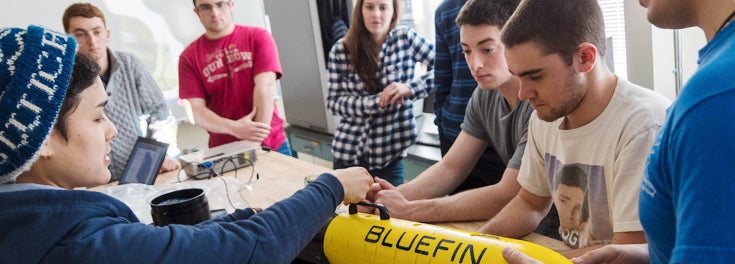 A team of URI engineering students is diving into one of the most mysterious places on Earth—by learning to create the next generation of autonomous underwater vehicles (AUV) that can explore the world’s oceans.
A team of URI engineering students is diving into one of the most mysterious places on Earth—by learning to create the next generation of autonomous underwater vehicles (AUV) that can explore the world’s oceans.
Working with Assistant Professor Stephen Licht, director of URI’s Robotics Laboratory for Complex Underwater Environments, 10 students are partnering with Bluefin Robotics to test and improve a 3-foot-long SandShark AUV under development by the Massachusetts research company. “Being able to build a vehicle and watch it work, that is pretty awesome,” said Rebecca Cressman, an ocean engineering student on the team.
Deployed by a wide variety of industries, AUVs often carry an array of sensors and cameras and dive deep into waters too foreboding for humans. They monitor ecosystems, find hidden historical treasures and, most recently, search for downed airliners.
I really wanted to give engineering students a chance to understand a vehicle design from soup to nuts, and this was the perfect chance.
Students in Professor Licht’s ocean engineering class met early this semester with Bluefin engineers and peered inside the company’s prototype AUV. In the lab, the students—representing ocean, mechanical, and electrical engineering— began construction of mock systems including sensors, electronics, and propulsion. Thanks to a Champlin Foundations grant, the class prints prototypes on a 3-D printer in a recently renovated lab at the URI Bay Campus just steps from Narragansett Bay.
Professor Licht encouraged students from different engineering disciplines to tackle the project together. Electrical engineering student Thomas Hamilton said that team-building experience will translate to a selling point on his resume. “Ultimately, in the real world, you’re going to end up working in different groups of people with different disciplines so it’s important to get that experience,” he said.
Before coming to URI, Professor Licht worked on marine robotic projects for iRobot, the company best known for its autonomous vacuum cleaners. Once at URI he attended a seminar given by Mathieu Kemp, then the director of concept development for Bluefin. When Kemp mentioned the company’s latest project, the professor asked about marrying it with his course. “I had it on my mind to do something like this for a while,” he said. “I really wanted to give engineering students a chance to understand a vehicle design from soup to nuts, and this was the perfect chance.”
